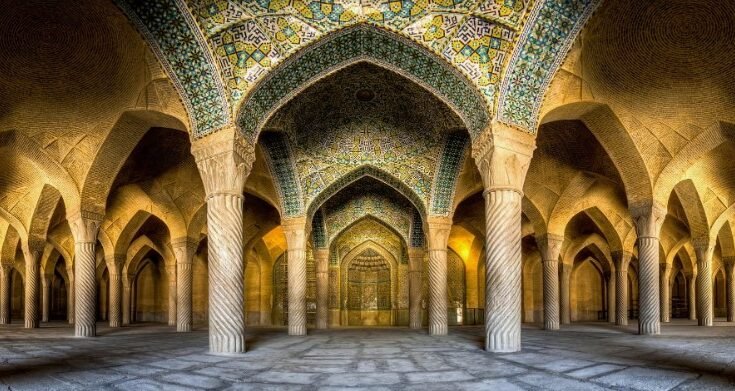
The holy month of Ramadan holds profound significance in the Islamic faith, marking a period of fasting, prayer, reflection, and community. Beyond its spiritual essence, Ramadan is also a time when Islamic art and architecture take center stage, offering a glimpse into the rich cultural heritage of the Muslim world. From intricate calligraphy to majestic mosques, Islamic art and architecture serve as expressions of faith, identity, and creativity, embodying centuries of tradition and innovation.
Understanding Islamic Art:
Islamic art is a diverse and vibrant form of expression that encompasses a wide range of styles, techniques, and mediums. Rooted in the teachings of Islam, Islamic art often incorporates elements such as calligraphy, geometric patterns, floral motifs, and arabesques. These artistic forms serve both decorative and symbolic purposes, reflecting the spiritual and cultural values of Muslim societies.
Calligraphy:
One of the most distinctive features of Islamic art is calligraphy, the art of beautiful writing. Calligraphy plays a central role in Islamic art, serving as a primary means of conveying sacred texts, particularly the Quran. Skilled calligraphers devote years of practice to mastering different scripts and styles, creating exquisite works of art that blend form and meaning seamlessly.
Some of the most prominent styles include Kufic, Naskh, Thuluth, and Diwani.
Geometric Patterns:
Another hallmark of Islamic art is geometric patterns, which adorn everything from textiles and ceramics to architecture.
Islamic geometric patterns are based on mathematical principles such as symmetry, proportion, and tessellation. The repetition and interlocking of geometric shapes create visually mesmerizing compositions that evoke a sense of awe and wonder. One of the most famous examples of Islamic geometric design is the intricate tilework adorning the walls of the Alhambra Palace in Granada, Spain. The geometric patterns in Islamic art not only serve decorative purposes but also convey deeper symbolic meanings, reflecting the Islamic worldview and cosmology.
Floral Motifs:
Flowers and plants hold special symbolism in Islamic art, representing beauty, fertility, and the natural world. Floral motifs feature prominently in Islamic art and architecture, adorning carpets, manuscripts, and architectural elements.
Islamic floral motifs draw inspiration from the diverse flora of the Muslim world, including roses, lilies, tulips, and palm trees. The use of floral motifs in Islamic art reflects a deep appreciation for the beauty of the natural world and serves as a reminder of the Creator’s bounty and generosity.
Arabesques:
Arabesques are ornamental designs characterized by flowing, intertwined lines, often inspired by plant forms and calligraphic flourishes. Arabesques symbolize the interconnectedness of all creation, reflecting the Islamic concept of unity and harmony.
Islamic arabesques are characterized by their fluid and rhythmic movements, evoking a sense of movement and vitality. These motifs are often used to embellish architectural elements such as arches, doorways, and windows, creating visually striking compositions that capture the imagination. Arabesques can also be found in other art forms such as ceramics, metalwork, and textiles, where they add a sense of elegance and sophistication to the design.
Islamic Architecture:
Islamic architecture is renowned for its grandeur, beauty, and intricate detailing, reflecting the cultural, religious, and historical contexts of Muslim societies. From mosques and palaces to madrasas and mausoleums, Islamic architecture encompasses a wide range of structures, each with its unique style and significance.
Mosques:
Mosques are central to Islamic architecture, serving as places of worship, education, and community gathering. Islamic mosques vary in design and layout, but they often feature certain architectural elements such as domes, minarets, and prayer halls. The design of mosques reflects both practical considerations, such as the need for prayer space and ventilation, as well as symbolic and aesthetic concerns, such as the emphasis on geometric patterns and calligraphic inscriptions.
The architecture of mosques varies across different regions and historical periods, reflecting the diverse cultural influences and architectural styles of the Muslim world. For example, the Great Mosque of Cordoba in Spain combines Islamic, Christian, and Byzantine architectural elements, reflecting the rich cultural exchange that occurred during the Islamic rule of Spain. Similarly, the Blue Mosque in Istanbul, Turkey, blends Ottoman and Byzantine architectural styles, creating a unique and harmonious synthesis of form and function.
Palaces and Fortresses:
Islamic palaces and fortresses are architectural marvels that showcase the wealth, power, and sophistication of Muslim rulers.
Islamic palaces and fortresses served not only as residences for rulers and their families but also as centers of administration, culture, and entertainment. These palaces often featured elaborate gardens, courtyards, and pavilions, creating tranquil and luxurious retreats for their inhabitants. The architecture of Islamic palaces reflects the social hierarchy and cultural values of the time, with grandiose facades and opulent interiors designed to impress and awe visitors.
Madrasas:
Madrasas are Islamic educational institutions where students study the Quran, Islamic law, and other religious subjects. These institutions played a crucial role in the transmission of knowledge and scholarship throughout the Islamic world.
Madrasas were not only centers of learning but also important symbols of religious and cultural identity. The architecture of madrasas reflects the values of education, piety, and community that are central to Islamic society. Many madrasas were built as charitable endowments, funded by wealthy patrons and rulers seeking to earn merit in the afterlife. These institutions provided free education to students from diverse backgrounds, fostering a spirit of intellectual inquiry and religious devotion.
Mausoleums:
Mausoleums are sacred sites where the tombs of revered figures, such as prophets, saints, and rulers, are enshrined. These monuments serve as places of pilgrimage and devotion, attracting visitors from around the world.
The architecture of Islamic mausoleums reflects the spiritual and cultural significance of the individuals buried within them.
Influence and Legacy:
Islamic art and architecture have left an indelible mark on world culture, influencing artistic traditions across continents and centuries. The geometric patterns, calligraphic scripts, and architectural forms of Islamic art have inspired artists, architects, and designers from diverse backgrounds. From the ornate tilework of the Alhambra to the towering minarets of the Taj Mahal, Islamic art and architecture continue to captivate and inspire audiences worldwide.
Islamic art and architecture have also played a crucial role in shaping the identity and worldview of Muslim societies. Through its emphasis on beauty, symmetry, and spirituality, Islamic art reflects the values of balance, harmony, and unity that are central to the Islamic faith. The legacy of Islamic art and architecture extends far beyond the boundaries of the Muslim world, influencing artistic movements such as the Renaissance in Europe and the Arts and Crafts movement in the 19th century.
Conclusion:
Ramadan is not only a time of spiritual reflection and devotion but also an opportunity to celebrate the rich cultural heritage of Islam. Through its art and architecture, Islam offers a window into a world of beauty, creativity, and tradition. From the intricate calligraphy of the Quran to the majestic domes of mosques, Islamic art and architecture serve as enduring symbols of faith, identity, and human ingenuity. As we unveil the treasures of Ramadan, let us also embrace the universal values of beauty, harmony, and unity that unite us all.



